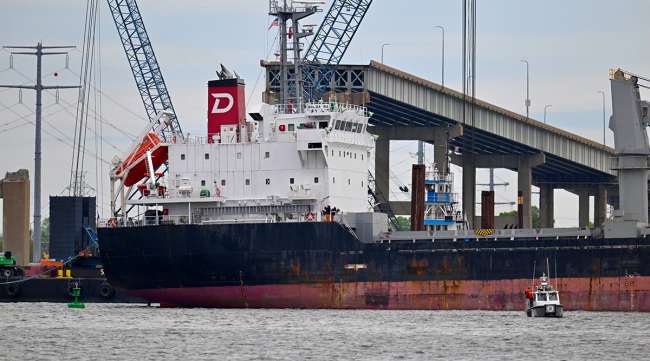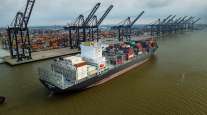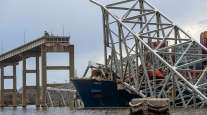First Ship Leaves Port of Baltimore via Deeper Channel

[Stay on top of transportation news: Get TTNews in your inbox.]
The first of 11 ships trapped for a month behind the wreckage of the Francis Scott Key Bridge left the Port of Baltimore the morning of April 25 using an alternate shipping channel that opened less than two hours earlier.
Balsa 94, a cargo ship, sailed just before 10 a.m. ET with the help of two tugboats, passing chunks of the fallen steel bridge and the still grounded Dali freighter that crashed into and destroyed the span March 26. The Balsa is headed to Saint John, New Brunswick, where it should arrive by early next week.
Coast guard officials said April 25 the channel had a depth of 38 feet, not 35 feet as originally announced. It is the deepest yet of four temporary, alternate routes in and out of the port. But the new Fort McHenry Limited Access Channel, for commercially essential vessels, will stay open only through 6 a.m. April 29, or through April 30 if weather adversely affects transit.
“The primary focus of this four-day period is to allow the ships that have remained within the Port of Baltimore since the March 26 incident to leave,” port officials said in a statement April 24.
The port has been blocked to most vessel traffic since the Dali struck a bridge support column March 26, causing the 1.6-mile bridge to collapse and killing six construction workers.
The general cargo ship Balsa 94 becomes the first ship to use the @portofbalt's 35-foot-deep Limited Access Channel promised by the @USACEHQ by the end of April. The ship had been stuck in the harbor since the March 26 collapse of the Key Bridge.
Updated story here:… pic.twitter.com/LZeE9o5rne — gCaptain (@gCaptain) April 25, 2024
The disaster blocked 11 large cargo ships from being able to leave the port.
Five of the vessels stranded, including a large car carrier, are expected to get out during the five-day window, said Capt. David O’Connell, the Coast Guard’s Captain of the Port for the Key Bridge Response Unified Command. Inbound vessels are expected to include a small bulk carrier and a ship carrying aluminum, he said.
Four of the 11 cargo ships docked at berths in the port have no “immediate” plans to depart just yet. They are part of the U.S. Maritime Administration’s Ready Reserve Force, a fleet established in 1976 to quickly supply American troops around the world. A spokesman for the U.S. Department of Transportation’s Maritime Administration said April 24 that he knew of no immediate plans to move those ships from the port.
The first commercial vessel transited through the Limited Access Channel at the #FSKBridge site Thursday, part of scheduled passages for a limited number of commercial vessels into the @portofbalt and a departure opportunity for deep draft vessels unable to leave the harbor. pic.twitter.com/KsfOffBkme — USACE Baltimore (@USACEBaltimore) April 25, 2024
The newest channel will be available along with three other temporary channels, with depths of 11, 14 and 20 feet. The new channel will be marked with lighted aids and limited to transit at the discretion of the Coast Guard’s captain of the port based on weather conditions.
Vessels must be operated by a Maryland State pilot and escorted by two tugboats at speeds at or below 5 knots because of the channel’s proximity to the grounded Dali. Ships with more than 60,000 long tons of displacement will most likely not be allowed through the channel.
After shutting down next week, the 35-foot channel will not reopen until around May 10, to allow salvage crews to begin lifting steel off the Dali and using a hydraulic grabber to clear debris from the harbor’s main 50-foot shipping channel. The Army Corps of Engineers expects to reopen the Port of Baltimore’s permanent 700-foot wide, 50-foot deep channel by the end of May.
The first three temporary channels have been in use by smaller vessels and barges. Domino Sugar, which has a refinery on the Inner Harbor in Baltimore’s Locust Point, posted on Facebook that the sugar barge Jonathan, which regularly delivers shipments of raw sugar to the refinery, returned April 24 using the 20-foot navigation channel.
“Thank you to the Coast Guard and the entire Unified Command who made this possible,” the manufacturer said in its post.
Baltimore Sun reporter Angela Roberts contributed to this article.
Want more news? Listen to today's daily briefing below or go here for more info:
Distributed by Tribune Content Agency, LLC




